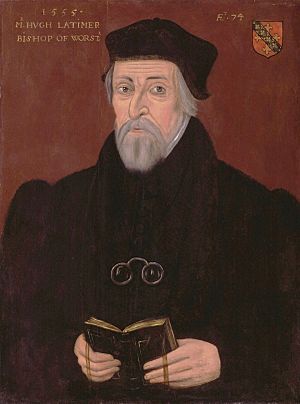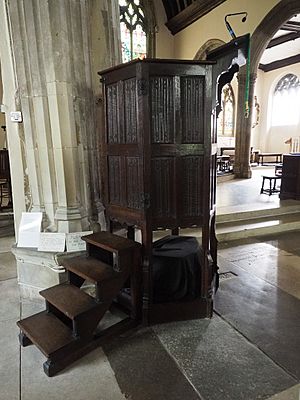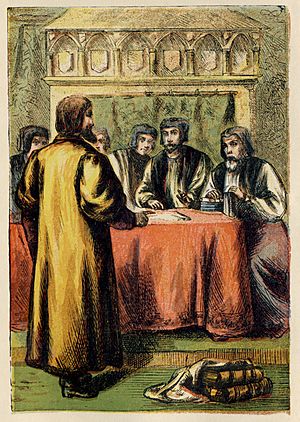Hugh Latimer facts for kids
Quick facts for kids The Right Reverend Hugh Latimer |
|
|---|---|
| Bishop of Worcester | |
 |
|
| Church | Church of England |
| Diocese | Worcester |
| In Office | 1535–1539 |
| Predecessor | Girolamo Ghinucci |
| Successor | John Bell |
| Other posts | Chaplain to the Royal Household |
| Orders | |
| Ordination | 15 July 1515 |
| Consecration | 1535 |
| Personal details | |
| Born | 1487 Thurcaston, Leicestershire, Kingdom of England |
| Died | 16 October 1555 (aged 67-68) Oxford, Oxfordshire, Kingdom of England |
| Nationality | English |
| Denomination | Anglicanism |
| Education | University of Cambridge |
| Alma mater | Clare College |
Hugh Latimer (born around 1487 – died 16 October 1555) was an important English religious leader. He was a Fellow at Clare College, Cambridge, and later became the Bishop of Worcester. He lived during the English Reformation, a time when the Church in England changed a lot.
Latimer also served as a chaplain to King Edward VI. In 1555, during the reign of Catholic Queen Mary I, he was executed by being burned at the stake. He is remembered as one of the three Oxford Martyrs of Anglicanism.
Contents
Early Life and Education
Hugh Latimer was born into a farming family in Thurcaston, Leicestershire. His exact birth date is not known, but it was likely around 1487. He started school at a young age, learning Latin grammar.
He went on to study at the University of Cambridge. In 1510, he became a fellow of Clare College. He earned his Master of Arts degree in 1514 and became a priest in 1515.
Becoming a Reformer
In 1522, Latimer became a university preacher and chaplain. He continued his studies and earned a Bachelor of Divinity degree in 1524. At first, Latimer strongly disagreed with the new ideas of the Protestant Reformation. He called himself "as obstinate a papist as any was in England."
However, a reformer named Thomas Bilney changed his mind. Bilney shared his beliefs with Latimer, which deeply affected him. From that day on, Latimer began to accept the reformed teachings.
Preaching and Challenges
Latimer joined a group of reformers, including Bilney and Robert Barnes. They often met at the White Horse Tavern. Latimer started to preach that the Bible should be translated into English. This was risky because the first English New Testament by William Tyndale had just been banned.
In 1528, Latimer was called before Cardinal Thomas Wolsey and warned about his preaching. The next year, Wolsey lost favour with King Henry VIII. This happened because Wolsey failed to quickly end Henry's marriage to Catherine of Aragon. Meanwhile, Latimer's reputation grew among the reformers in Cambridge.

Bishop of Worcester
In 1535, Hugh Latimer became the Bishop of Worcester. He took over from an Italian bishop who was often absent. As bishop, Latimer promoted reformed teachings. He also supported iconoclasm, which meant removing religious images from churches.
In 1539, Latimer spoke out against King Henry VIII's Six Articles. These laws supported traditional Catholic beliefs. Because of his opposition, Latimer was forced to resign as bishop. He was then imprisoned in the Tower of London.

After being released, he served as chaplain to Katherine Duchess of Suffolk. However, when Mary I became queen, Latimer was arrested again. He was tried for his Protestant beliefs in Oxford and imprisoned.
Trial and Conviction
On 14 April 1554, a group of officials from the Catholic party began to question Latimer, along with Nicholas Ridley and Thomas Cranmer. Latimer was quite old and found it hard to debate. He gave his answers in writing.
He argued that certain Catholic beliefs about the presence of Christ in the Mass were not found in the Bible. The officials tried to show that Latimer's faith was different from earlier important Church leaders. Latimer replied that he agreed with them only when they used the Bible to support their ideas.
Latimer believed it was important to stand up for the Protestant understanding of the Christian message. The officials also felt that the debate was about how people would be saved. After he was sentenced, Latimer said, "I thank God most heartily that He hath prolonged my life to this end, that I may in this case glorify God by that kind of death."
Death and Legacy

Hugh Latimer was burned at the stake with Nicholas Ridley. As the fire was lit, Latimer famously said to Ridley: "Play the man, Master Ridley; we shall this day light such a candle, by God's grace, in England, as I trust shall never be put out."
Their deaths, along with that of Thomas Cranmer, are remembered as the Oxford Martyrs. In Oxford, a monument called the Martyrs' Memorial stands near where they were executed. A cross in Broad Street marks the exact spot.
Commemoration
Hugh Latimer and Nicholas Ridley are honored by the Church of England, the American Episcopal Church, and the Anglican Church of Canada. Their commemoration day is 16 October.
- The Latimer room at Clare College, Cambridge, is named after him.
- Latimer Square in central Christchurch, New Zealand, also bears his name.
See also
 In Spanish: Hugh Latimer para niños
In Spanish: Hugh Latimer para niños

